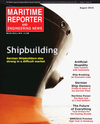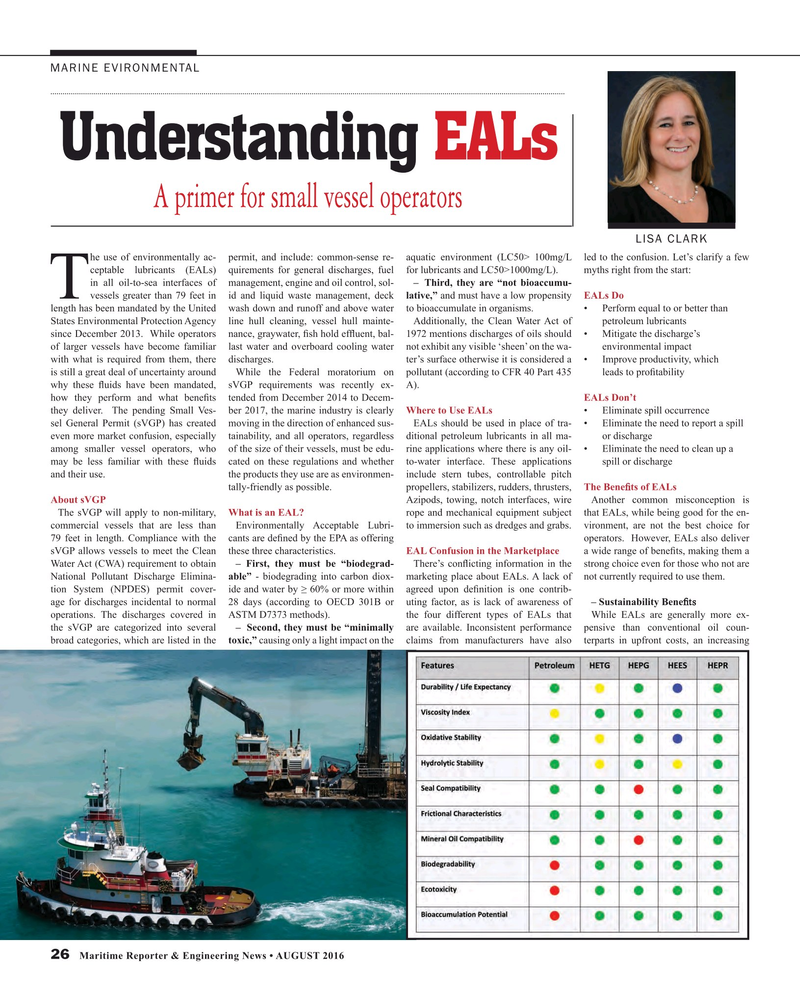
Page 26: of Maritime Reporter Magazine (August 2016)
The Shipyard Edition
Read this page in Pdf, Flash or Html5 edition of August 2016 Maritime Reporter Magazine
MARINE EVIRONMENTAL
Understanding EALs
A primer for small vessel operators
LISA CLARK he use of environmentally ac- permit, and include: common-sense re- aquatic environment (LC50> 100mg/L led to the confusion. Let’s clarify a few ceptable lubricants (EALs) quirements for general discharges, fuel for lubricants and LC50>1000mg/L). myths right from the start: in all oil-to-sea interfaces of management, engine and oil control, sol- – Third, they are “not bioaccumu-
Tvessels greater than 79 feet in id and liquid waste management, deck lative,” and must have a low propensity EALs Do length has been mandated by the United wash down and runoff and above water to bioaccumulate in organisms. • Perform equal to or better than
States Environmental Protection Agency line hull cleaning, vessel hull mainte- Additionally, the Clean Water Act of petroleum lubricants since December 2013. While operators nance, graywater, ? sh hold ef? uent, bal- 1972 mentions discharges of oils should • Mitigate the discharge’s of larger vessels have become familiar last water and overboard cooling water not exhibit any visible ‘sheen’ on the wa- environmental impact with what is required from them, there discharges. ter’s surface otherwise it is considered a • Improve productivity, which is still a great deal of uncertainty around While the Federal moratorium on pollutant (according to CFR 40 Part 435 leads to pro? tability why these ? uids have been mandated, sVGP requirements was recently ex- A). how they perform and what bene? ts tended from December 2014 to Decem- EALs Don’t they deliver. The pending Small Ves- ber 2017, the marine industry is clearly Where to Use EALs • Eliminate spill occurrence sel General Permit (sVGP) has created moving in the direction of enhanced sus- EALs should be used in place of tra- • Eliminate the need to report a spill even more market confusion, especially tainability, and all operators, regardless ditional petroleum lubricants in all ma- or discharge among smaller vessel operators, who of the size of their vessels, must be edu- rine applications where there is any oil- • Eliminate the need to clean up a may be less familiar with these ? uids cated on these regulations and whether to-water interface. These applications spill or discharge and their use. the products they use are as environmen- include stern tubes, controllable pitch tally-friendly as possible. propellers, stabilizers, rudders, thrusters, The Bene? ts of EALs
About sVGP Azipods, towing, notch interfaces, wire Another common misconception is
The sVGP will apply to non-military, What is an EAL? rope and mechanical equipment subject that EALs, while being good for the en- commercial vessels that are less than Environmentally Acceptable Lubri- to immersion such as dredges and grabs. vironment, are not the best choice for 79 feet in length. Compliance with the cants are de? ned by the EPA as offering operators. However, EALs also deliver sVGP allows vessels to meet the Clean these three characteristics. EAL Confusion in the Marketplace a wide range of bene? ts, making them a
Water Act (CWA) requirement to obtain – First, they must be “biodegrad- There’s con? icting information in the strong choice even for those who not are
National Pollutant Discharge Elimina- able” - biodegrading into carbon diox- marketing place about EALs. A lack of not currently required to use them.
tion System (NPDES) permit cover- ide and water by = 60% or more within agreed upon de? nition is one contrib- age for discharges incidental to normal 28 days (according to OECD 301B or uting factor, as is lack of awareness of – Sustainability Bene? ts operations. The discharges covered in ASTM D7373 methods). the four different types of EALs that While EALs are generally more ex- the sVGP are categorized into several – Second, they must be “minimally are available. Inconsistent performance pensive than conventional oil coun- broad categories, which are listed in the toxic,” causing only a light impact on the claims from manufacturers have also terparts in upfront costs, an increasing 26 Maritime Reporter & Engineering News • AUGUST 2016
MR #8 (26-33).indd 26 8/1/2016 2:44:39 PM

 25
25

 27
27
